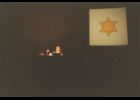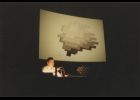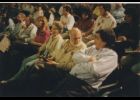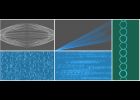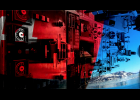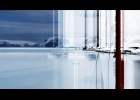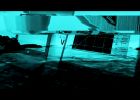The construction of happiness in the world of technical images: from Aristotelian ‘’ευδαιμονία (eudaimonia)’’ to the image-synthesis of Vilém Flusser
This paper explores the concept of happiness in modern times through the lens of Vilém Flusser’s technical image comparing it to the Aristotelian concept of eudaimonia. According to Aristotle, eudaimonia is the supreme good to which human beings should dedicate their life. The process of finding eudaimonia is an extremely difficult journey. Is this concept still valid in the age of technical images that compose the reality around us? What does happiness mean in this situation? How can we give any meaning to it? An answer to these questions can be found in Flusser’s thought.
Colorarium: The Exchange of Letters between Vilém Flusser, Karl Gerstner, Philippe Henry and Gottfried Jäger
This essay is about the relationship and collaboration between Vilém Flusser, Karl Gerstner, Philippe Henry, and Gottfried Jäger and the way this impacted the project of the House of Colour in São Paulo between 1987 and 1989. In this period, Flusser exchanged numerous letters and texts with his three correspondents, continuously re-elaborating and expanding his ideas about colour and their specific role in the project. This communication process was naturally enough multilingual. Flusser used English, German and Portuguese interspersed with French. Jäger wrote his texts in German, Gerstner in German and English, and Henry used Portuguese and French. The plurality of idioms is echoed in the use of different media. Besides forms of written communication (letters, essays, telegrams), video interviews were done in Robion, which were viewed and commented upon in Brazil. Henry conveyed the questions by phone and Flusser reacted in written form. Gerstner and Flusser wrote several texts together. Flusser travelled three times to Brazil, visited Gerstner in Basel and Hippoltskirch and Jäger in Bielefeld. Both Gerstner and Jäger came to see him in Robion. Henry travelled several times to Robion, and also met Gerstner and Jäger. All this ensured a constant flow of back-and-forth information within the small network of friends.
Coloured technical images: On the Role of Colour in Vilém Flusser’s Work
Flusser wrote about colour from different points of view His interdisciplinary approach defies clear-cut borders by contaminating that which is generally thought to be separated. It rather seeks to create complex syntheses that play a privileged role in his texts on colour. In the same way, colours do not stick to the forms into which one tries to imprison them. They overflow, blend and bleed into each other. This essay focuses on four aspects of colour: the connection of black and white in photography and discourses on “racial” differences; the role of greyness and its relationship to colour luminosity in the description of culture and politics; the presence of colour in nature, landscape, and the animal world; Flusser’s use of colour in a redefinition of the notion of technical images in the context of the project of the Casa da Cor.
Al-Zahir
The Zahir in Jorge Luis Borges’ story is an object by which men become obsessed and are no more able to see anything beyond it. The mystery: why does the Zahir has this attractor power? Borges questions himself the reason why Tennyson said that if we could understand one single flower, we could understand what the world is. “Perhaps he was trying to say that there is nothing, however humble, that does not imply the history of the world and its infinite concatenation of causes and effects.” And then the Zahir would also have this potency of revealing the nature of being and existence. I conciliate Deleuze’s object’s ontology and Flusser’s concept of virtuality with aspects of the Sufi philosophy in order to investigate how a single object manifests itself, what are its potencies of existence beyond the real and the relations this object maintains with other systems to comprehend the whole through it.
Notes on Antarctica Tempo
This article is the outcome of an audiovisual performance proposed for the Conference Vilém Flusser and His “Languages.” It presents the concept, aesthetic and technical choices on Antarctica Tempo, a Live Cinema work of art and science resulting from a 60-day expedition to Antarctica. The perception of this place and the pace of the trip are mixed with scientific research, my subjective view, and control within the military environment. It is a mixture of codes – software and language – that try to translate the experience lived in that distant place. The language I want to portray here is the technical image, the remix of this imagined place and tempo.
Reversing the vectors of meaning. The diagrammatic language of Vilém Flusser
According to his own cultural analysis, Flusser was a man of yesterday. He, who wrote nearly every day of his life, was himself subject to the “textolatry” of modernity. A modernity, though, which would soon shift into a new epoch which Flusser and others had given similar names: post-histoire, post- modernity, information or telematic society. In this new situation, according to Flusser, written text would become a marginal code, soon to be superseded by the “technical image” as universal means of communication and information storage. Thus, Flusser described authors like himself, which would stay engaged with text, as “the new illiterates” of the upcoming age. But although Flusser was a man of the written word, I will argue that there was at least one type of sign system with which he also operated frequently and which can be linked to his image heuristics: the diagram. Scattered over his manuscripts, letters and notes, over 160 diagrammatic sketches can be found in the Vilém Flusser Archive. Compared to the thousands of documents in the archive, this seems to be a small number. But his diagrammatic sketches are not only interesting considering the nearly exclusively textual character of Flusser’s legacy; they can also be described as Flusserian technical images. According to the semiotic definition of the diagram by Charles S. Peirce, diagrammatic signs constitute a specific subclass of the icon: A diagram resembles its object not by visual but structural similarity. By drawing a diagram, one proposes a hypothesis about the structure of its object, thus manifesting an abstract concept as a concrete sign. Here we come close to Flusser’s notion of technical images as projections of abstract models. Following up on this comparison, the paper pleas for a non-trivial relation between Flusser’s heuristic of the technical image and his diagrammatic practice.
The Fourth Meaning of the Image: Flusser’s Invitation to Envision the World
This short essay is composed of excerpts from the doctoral thesis entitled Image as Articulation of Thought. It focuses on a few inputs by Vilém Flusser on the subject of the technical image and the necessity of becoming active participants in the illusory world we are now living in. For this to happen, we must step out of our condition of being functionaries and become (en)visionaries. That is, we must step out of a linear model of thinking into a superficial one, one that is based entirely on images.
Can We Think Computation in Images or Numbers? Critical Remarks on Vilém Flusser’s Philosophy of Digital Technologies
The article questions Flusser’s concept of the computational universe based on technical images. Emphasizing the role of the calculative, formal consciousness the article suggests a non-representational, non-hermeneutical approach to “calculating machines” as machines that allow to mechanize a certain type of thinking (mathematical thinking). At the same time, the article reformulates Flusser’s search for a new philosophy as a critical intervention into the programmed universe, arguing that this philosophy must not follow its technical logic, but find a way to reflect how different techniques and practices shape the numerical, imaginative and textual consciousness.
Raising the Temperature of the Conversation in the 21st Century
The main goal of this presentation was to connect our wireless culture populated by “smart objects” and Flusser’s predictions for a telematics society, as well as to examine the inversions he envisioned in the exchanges between art and science. Seven artists have been included in the slide presentation: Eduardo Kac, a pioneer of Bio Art eroding boundaries between subject and object; Paul Miller, who creates sound pieces from scientific data; Laura Poitras’s documentary films and exhibition about surveillance and the use of remote technologies in war as well as Andrea Fraser’s institutional critique; Giselle Beiguelman articulating the concept of techno-cannibalism; Lucas Bambozzi exploring the invisibility of electronic waves, issues of obsolescence and waste; and the work of Cuban artist Ernesto Oroza’s notion of “technological disobedience”.
The Unassimilable Image
This short essay considers Flusser’s thoughts concerning the relationship between image and language in light of Hubert Damisch’s Theory of /Cloud/. It explores the degrees to which the image—despite a flood of contemporary manifestations particularly of what Flusser called the ‘technical image’—remains resistant to textually based systems of communication and (scientific) knowledge. It proposes a necessary openness to the image where, given the nature of how sense is made regarding the multiple ways it can be approached or ‘read’, provisionality and indeterminacy are essential, positive attributes.
Considering linear perspective as a precursor to the technical image, the paper explores the sense in which the ineffable—seen as intrinsically related to Damisch’s notion of /cloud/—is inseparable from and perhaps essential to the representational systems signified by the camera or the computer. These emerge from a constantly developing ‘net’ of language through which knowledge about the world is defined and acquires its dizzying complexity. This net is regarded as intertwined with, yet of a different order to, the image. Flusser’s technical image locates this concept firmly within a linguistic system but such an image still has echoes of its origins, and is thus open to difference in terms of how it is approached and what can be drawn from it. This is a productive incompleteness. Some of the author’s visual works, which are thoroughly enmeshed with the thoughts that have led to such thinking, are represented and function as asides, responses, or counterbalances to the ideas explored in the text.
